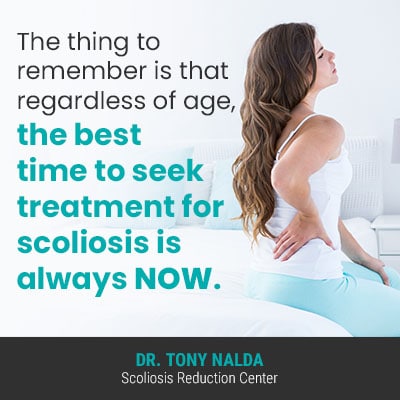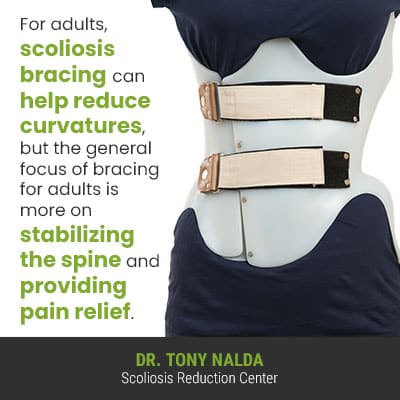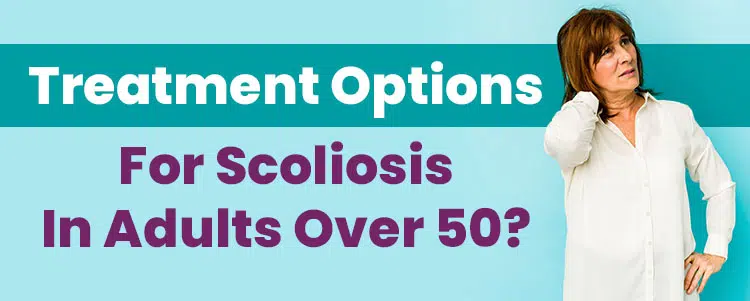While most people think of scoliosis as an adolescent condition, it also affects adults. The two most common condition types diagnosed in adults are idiopathic and degenerative. Adults over the age of 50 are susceptible to natural age-related spinal degeneration, and whether they’ve had scoliosis for years but were unaware or have developed it fresh in adulthood, treatment options vary.
Adult scoliosis treatment plans will be shaped by the condition type in question. Treatment options for adults will be case-specific but commonly focus on improving spinal support/stabilization, preserving spinal function, preventing further degenerative changes, and pain management.
Let’s start our discussion of treatment options for scoliosis in adults over 50 by first exploring the most common condition types to affect adults.
Scoliosis in Adults
One of the reasons scoliosis is so often deemed a complex condition is because there are multiple severity levels and condition types a person can develop, associated with different causes.
The most prevalent form of scoliosis is adolescent idiopathic scoliosis (AIS), diagnosed between the ages of 10 and 18, and the idiopathic designation means it’s not clearly associated with a single causative source; it’s instead considered multifactorial .
Idiopathic scoliosis accounts for 80 percent of known diagnosed cases, and the remaining 20 percent are associated with known causes: neuromuscular, congenital, degenerative, and traumatic scoliosis.
The most common type affecting adults is adult idiopathic scoliosis, which are cases of AIS that went undiagnosed and untreated in adolescence, progressing into adulthood when symptoms tend to become more overt.
 Adult Idiopathic Scoliosis
Adult Idiopathic Scoliosis
As mentioned, AIS is the most prevalent type of scoliosis, but the condition isn’t always easily detected, particularly in mild cases that tend to produce subtle postural changes and aren’t generally associated with pain or functional deficits.
In fact, this leads us to one of the main differences in the adolescent versus the adult experience of scoliosis: pain.
Pain is the number-one symptom of adult scoliosis, but prior to reaching skeletal maturity, the lengthening motion of a growing spine counteracts the compression caused by the unnatural spinal curve, which is the main cause of pain; for the aforementioned reasons, although early detection can be so beneficial in terms of treatment, it isn’t always easily achieved in adolescents.
When skeletal maturity is reached in adulthood, this is when conditions tend to become painful, and this is when most adults with idiopathic scoliosis come to see me for a diagnosis and treatment.
The unfortunate reality is that had these patients received a diagnosis and treatment in adolescence, and their spines would be in far better shape than they are by the time they see me.
For adults over the age of 50 recently diagnosed with idiopathic scoliosis, in addition to back or radicular pain felt in the legs and feet, symptoms can include postural deviation such as a prominent lean to one side, a rib arch, and uneven shoulders and hips.
In addition, changes to balance and gait are common.
The second most common condition type to affect adults is degenerative scoliosis.
Degenerative Scoliosis
Once again, although most consider scoliosis as a child and adolescent condition, current studies have found that when it comes to the actual percentages of adults with scoliosis, these are higher.
Common estimates put the rate of scoliosis in adolescents at 2 to 4 percent, while adult scoliosis rates are estimated to fall between 12 and 20 percent.
Spinal degeneration is a common cause of scoliosis in the elderly, and because aging women go through menopausal changes, such as a loss of bone density and hormonal changes, they are more likely to develop an unnatural scoliotic curve.
In most cases, the first structures of the spine to show signs of degeneration are the intervertebral discs that sit between adjacent vertebrae (bones of the spine).
As these discs provide the spine with structure, flexibility and act as its shock absorbers, when one or more of the discs experience degenerative changes, they can become desiccated, bulging, and/or herniated. All of these conditions can compromise the spine’s ability to maintain its natural curvatures and alignment.
Degenerative disc disease and scoliosis often present together because disc health is an important factor when it comes to preserving overall spinal health and function.
While a certain amount of natural spinal degeneration is to be expected with age, additional lifestyle factors can either minimize these changes, or make the spine more vulnerable to them.
Factors such as carrying excess weight, leading a sedentary lifestyle, chronic poor posture, smoking, and repeatedly lifting heavy objects incorrectly can have a negative cumulative effect on spinal health by introducing adverse spinal tension, uneven wear, and tear, and increasing the risk of injury.
So now that we have talked about the most common types of scoliosis to affect adults as they age let’s talk about treatment options for older adults.
Treatment Options for Adults Over 50
As a progressive condition, it’s in the very nature of scoliosis to worsen over time, particularly if left untreated, or not treated proactively.
When treating children and adolescents, the risk of rapid-phase progression is higher than in adults because the main trigger for scoliosis progression is growth and development.
Once skeletal maturity has been reached in adulthood, the trigger of growth is removed, but once age-related spinal degeneration comes into play, that can increase progressive rates in adults.
As a structural spinal condition, regardless of age, there is always the goal of a curvature reduction on a structural level, but when it comes to treating scoliosis in adults, the focus can shift from significant curvature reductions to smaller corrections, improving spinal support/stabilization, and pain management.
The thing to remember is that regardless of age, the best time to seek treatment for scoliosis is always now.
The Scoliosis Reduction Center® and Adult Scoliosis Treatment
Here at the Scoliosis Reduction Center®, I’ve treated patients of all ages, including adults over 50, and the first step of effective treatment is a comprehensive assessment to determine a condition’s underlying cause.
Once I know the condition type an adult is living with, I can craft treatment plans to address important patient/condition variables to impact their scoliosis on multiple levels.
By combining condition-specific chiropractic care, in-office therapy, custom-prescribed home exercises, and bracing, I can help my adult patients work towards a spine that’s stronger, more flexible, stable, optimally supported, and less painful.
One of the benefits of starting treatment early in a condition’s progressive line is that the body hasn’t had ample time to adjust to the curve’s presence, and as scoliosis progresses, the spine gets more rigid, less flexible, and treatment needs become more complex.
With my adult patients, significant progression has already occurred in many cases, so many patients may need prep work done to restore a degree of spinal flexibility before applying other forms of treatment to make the spine more responsive.
Through gentle and precise chiropractic adjustments, I can address areas of vertebral subluxation, work towards adjusting the position of the most-tilted vertebrae (bones of the spine) back into alignment with the rest of the spine, and improve disc health and function.
Particularly with degenerative scoliosis, condition-specific chiropractic care can help take pressure off affected discs; when a disc has changed shape, adjusting adjacent vertebrae may help a disc reclaim its central position between vertebral bodies.
Improving circulation around a degenerating disc can also help its ability to restore and heal itself as it absorbs important nutrients needed for cellular repair through osmosis, and a combination of chiropractic care and physical therapy can help with this.
Scoliosis-specific exercises (SSEs) and stretches are part of a variety of physical therapy techniques that can help adult patients increase their core strength for optimal spinal support/stabilization, and when integrated into a customized treatment plan, SSEs can also help activate certain areas of the brain for improved brain-body communication, postural remodeling, and better body positioning.

For adults, scoliosis bracing can help reduce curvatures, but the general focus of bracing for adults is more on stabilizing the spine and providing pain relief.
In most cases of adult scoliosis, the goal is to reduce a scoliotic curve to the size it was before it started to become painful and symptomatic, whereas when treating scoliosis in adolescents, the focus is to get as much of a reduction as possible to counteract the trigger of growth/development.
When working with adults, the risk of rapid progression is not as pressing, so more time can be taken to manage pain, restore mobility limitations, improve spinal function, and restore the body’s balance and symmetry to address related postural deviation.
Conclusion
While early detection and proactive treatment can be beneficial in terms of potential treatment success, regardless of age, it’s never too late to start scoliosis treatment; improvements can always be worked towards in terms of pain management and quality of life.
The two main types of scoliosis to affect adults are adult idiopathic scoliosis, which is an extension of adolescent idiopathic scoliosis left untreated and undiagnosed until adulthood, and degenerative scoliosis that develops over time.
Here at the Scoliosis Reduction Center®, I can help adults over 50 make improvements to their overall spinal health and function by working towards curvature reductions on a structural level, increasing core strength for optimal spinal support/stabilization, and improving intervertebral disc health.





